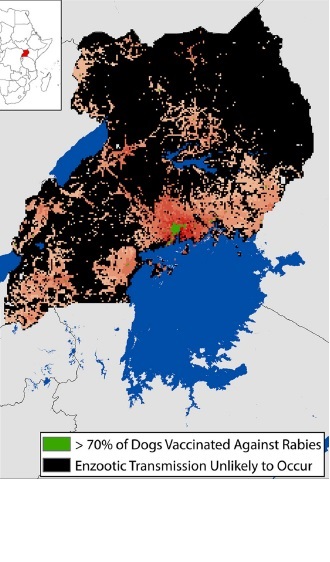Linking poverty to dog ownership models shrinks dog population estimates
- Community News
In a recent article in Infectious Diseases of Poverty, researchers published a new, more comprehensive model for estimating dog populations that considers how variability in poverty levels and human population densities can impact dog ownership and rabies vaccination coverage. Using these new models, the researchers estimated that current dog population levels in Uganda were much lower than those previously predicted. This decrease in predicted dog population levels–if validated–may strongly influence the current understanding of the rabies burden in Africa and the feasibility of rabies elimination in this region.
The new dog population models were developed using the results of knowledge, attitudes and practice (KAP) survey conducted in 24 villages in Uganda with diverse poverty levels, dog ownership practices, and population densities. The results represent 798 households, and the analyses took into consideration several variables, including poverty levels (calculated from the percent of people living below the international poverty level of US$1.25 per day), population density, household size and the level of dog care provided.
After data collection, the models, built using multilevel logistic regression, were used to predict dog population and vaccination coverage for the entire country. Researchers found that obtaining accurate projections of dog populations may not be as straightforward as simply applying the overall human:dog ratio to country-wide population numbers. Instead, the poverty level and human population density for a region should also be considered for more accurate dog population approximations.
The results of the KAP study showed that dog ownership was lower in high poverty/low population density (poor/rural) areas, lower in low poverty/high population density (affluent/urban) areas but higher in high poverty/ high population density (poor/urban) areas. When these factors were incorporated into a multivariate regression model, the estimated number of dogs country-wide also dropped. After adjusting for poverty and human population, the human:dog ratio was 47:1, and the total number of dogs in Uganda was 729,486 dogs. This represents a two-fold drop compared to population estimates based solely on the unadjusted human:dog ratio of 25:1, which gives a dog population size of 1,373,844.
Additionally when poverty was considered, rabies vaccination rates also showed a significant decrease, from 57% unadjusted to 35.4% overall coverage nationally. Researchers then used the modeled estimates of dog population density and vaccination coverage to determine where in Uganda the risk of rabies would be highest (see figure). Areas where fewer than 4 dogs /km2 exist (black areas in the figure) and areas where more than 70% of the dogs were vaccinated (green areas in the figure) were presumed not to be able to sustain transmission of rabies. For other areas, increasingly darker shades of red indicate a greater risk of rabies to people living there. These modeled estimates showed that nearly 90% of Ugandans live in communities where enzootic rabies transmission is possible and highlight where rabies vaccination resources are most needed.
This study was one of the very first to show how poverty levels impact dog population levels, but further validation of these models needs to be undertaken to ensure that the estimates obtained through these methods are accurate. In particular this model does not include unowned dogs, which cannot be estimated accurately from a KAP survey. The population predictions developed here create a more refined understanding of the pattern of dog distribution in Uganda, knowledge which can be used to enhance current vaccination strategies, but they cannot be used to replace the knowledge gained through routine rabies surveillance.
Even so, understanding that poverty impacts dog populations and the rabies risk by creating a non-uniform pattern of distribution will be essential when planning and implementing rabies control efforts in African countries with high poverty levels. These findings should allow for more effective rabies vaccination campaigns as well as allow for rabies control resources to be directed to regions where they will have the greatest impact for more effective outcomes.
Submitted by Laura Baker, GARC, summarized from “The impact of poverty on dog ownership and access to canine rabies vaccination: results from a knowledge, attitudes and practices survey, Uganda 2013” by Wallace et al. in Infectious Diseases of Poverty (2017) 6:97.
